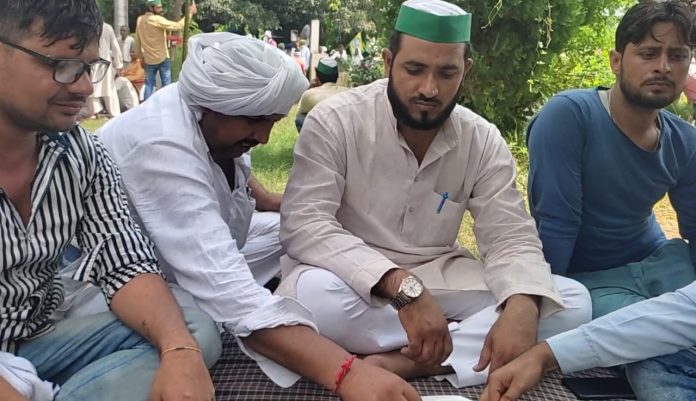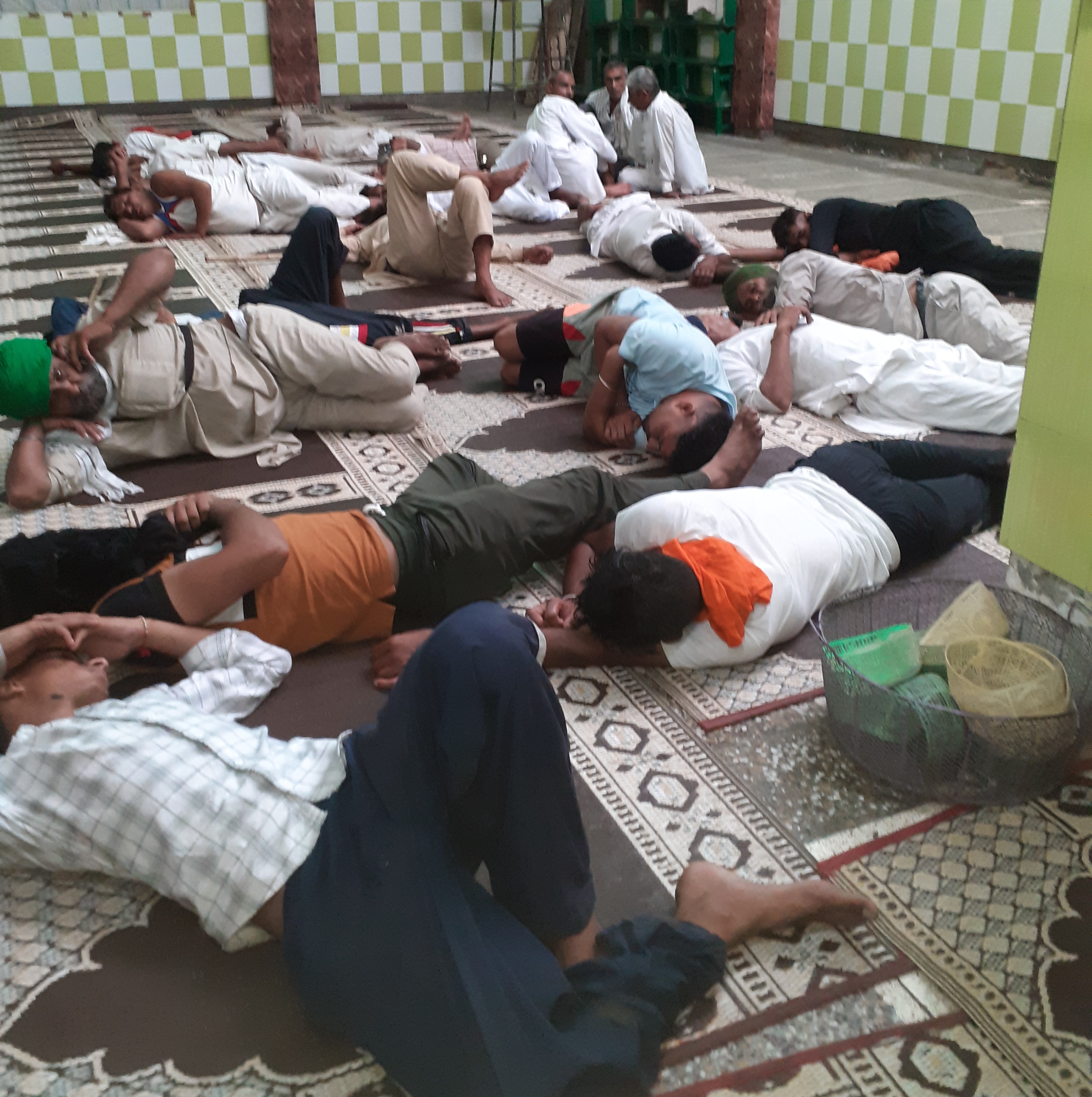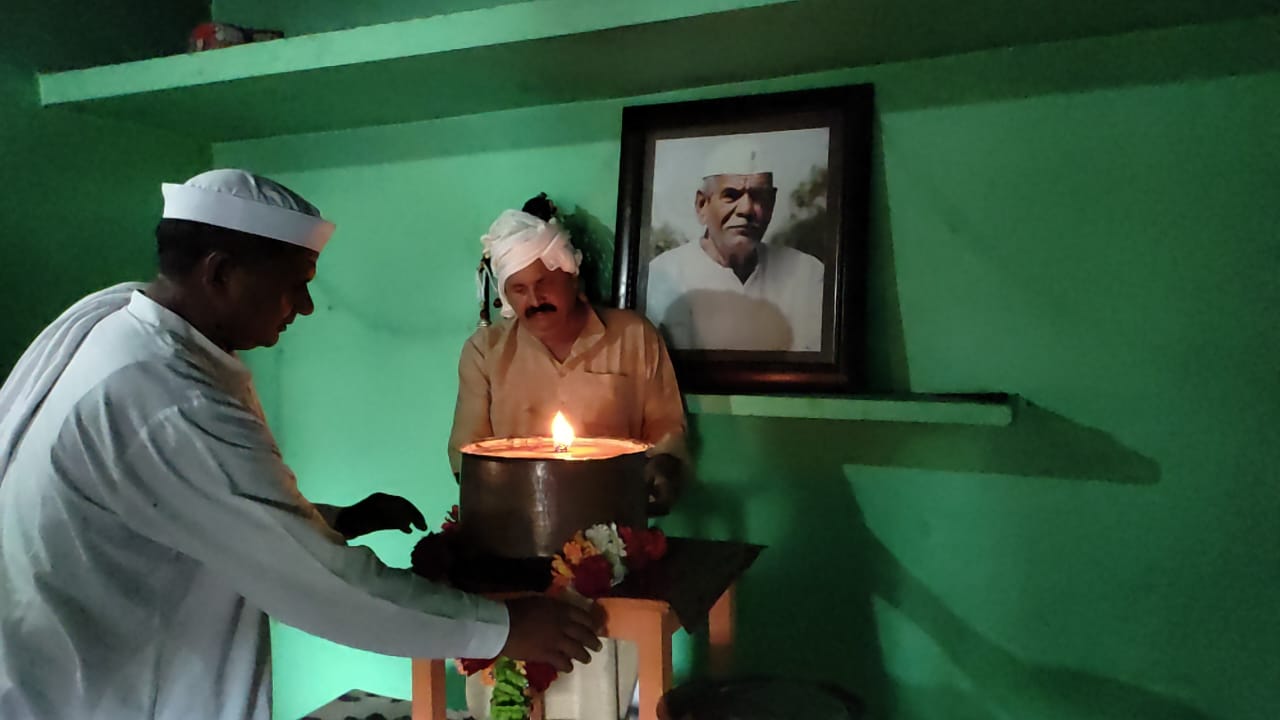
From opening the doors of the mosque to farmers, to organizing ‘Langers’ in Muslim-dominated areas and the slogans of ‘Allahu Akbar and Har Har Mahadev’ by Rakesh Tikait, the mood in Muzaffarnagar has changed. The Jat-Muslim unity has been revived again. Although the late Chaudhary Ajit Singh made the most efforts for this unity, it is Rakesh Tikait who has done the wonders.
Aas Mohammed Kaif | TwoCircles.net
MUZAFFARNAGAR – Mohammad Hassan, 45, oversees the ‘Takia Wali’ masjid located on GT Road located nearby the city’s famous square Meenakshi. These days, Mohammad Hassan is being widely appreciated. It is because his “Takiya Wali Masjid” had opened its doors for the farmers who were wandering on the road on the night of September 4. Hundreds of farmers, which included some women, not only took shelter in the mosque but were also fed food here.
Mohammad Hassan told TwoCircles.net that it was about 1 o’clock late in the night when some farmers had gathered on the road outside the mosque. The farmers were from the Sikh community, and included women. “I understood that these farmers had come to participate in the Mahapanchayat. The city is very crowded and they were facing problems as they had women accompanying them. I spoke to the people of the Masjid Committee for this and Faizan Ansari, Amir Azam and Dilshad Pehalwan advised me to shelter them. Soon after this, the volunteers of the Masjid Committee arrived at the mosque and the farmers were invited inside the mosque after requesting them. There were 50-60 farmers, out of which 7 were women. At 2 o’clock in the night, the mosque was thrown open and hundreds of farmers came inside to rest.”
Faizan Ansari, one of the caretakers of the mosque, told TwoCircles.net that “there was a lot more crowd (in Muzaffarnagar) than expected.”
On September 5, the world saw the crowd of farmers, but a more dire situation had arisen a day earlier. More than one lakh farmers of Haryana, Punjab and Rajasthan had come here on the night of September 4, which the organizers had not anticipated.
“These were our guests, so we tried to help them. We have seen how often the Gurdwaras do this for us. Today we did this for them,” Faizan Ansari said.

Faizan said that some of them were Hindu Jat farmers of Haryana, “Interestingly some of them were even wearing a saffron-coloured gamchha (towel) and one of them told me that their thinking towards Muslims has completely changed after this,” he said.
Amir Azam, a local citizen who came to offer Fajr namaz (morning prayers) at the mosque, told TwoCircles.net that when he arrived at the mosque to offer morning prayers on the morning of September 5, he saw a wonderful sight of people of the Muslim community offering Namaz in the inner room, “while the farmers stood up facing towards Kaba, with folded hands and were meditating.”
Another local citizen, Dilshad Pehalwan, arranged food for these farmers and they were fed the famous tahri of Muzaffarnagar.
Dilshad told TwoCircles.net that, “At the time of Adhan (Muslim call for prayer), these farmers of Haryana and Punjab stand up immediately in respect for the call and sit down after the Adhan.”
In the city of Muzaffarnagar, which has witnessed communal riots in the past, the opening of the doors of a mosque to farmers of different religions (most of them from the Jat community) is not a change that has occurred in a day.
Rashid Ali, a social worker of the city, told TwoCircles.net that the city has realized that the riots that happened 8 years ago were a political conspiracy. “Everyone is full of self-loathing for that mistake. Both Jat and the Muslim community wants to come closer to each other. Both communities want to remove that stigma,” he said.
Ali’s assessment seems true as langars were set up for farmers outside the Muslim-majority villages on the way to Muzaffarnagar and also on the way to Bijnor at a distance of 10 km along the road like Sherpur, Nirana and Bahadurpur. This langar was organised by the Muslims of the village. Villages like Sikheda, Nagla Mandaur and Kawal villages are on this route.
Sharanveer Chaudhary and Nawaz Khan of the Nagla Mandaur village together set up a Dhaba (a roadside food stall) for the farmers, in which at least 10 thousand farmers ate food. It is the same village where riots broke out in 2013.
This Dhaba was set up near Muzaffarnagar-Janasath.
Sharanveer Chaudhary and Nawaz Khan told TwoCircles.net that, “Even brothers fight between themselves but that does not mean they get separated forever.”
When Muslims made pudding for the farmers coming from Bahsuma in Sherpur village and distributed fruits, Parvinder of Bahsuma, riding in the tractor, said, “that an attempt was made to create a rift among the farmers by dividing them as the British had done.”
“But today we have become one again. The same village was accused of pelting stones at a tractor returning from the panchayat in the 2013 riots,” he said.
This Muzaffarnagar panchayat of farmers was successful in washing away the stigma of the riots and keeping the farmers rise above caste and religion.
Parvinder of Bahsuma said, “We are farmers and this is our only caste. The government is committing atrocities on farmers and now we have to save our agriculture. We will not fight with each other anymore like in the past.”
People in Muzaffarnagar are trying to figure out why Rakesh Tikait, a popular farm leader, chose the date of September 5, 2021, for the Mahapanchayat. It is being said that the Panchayat of 2013 was held on September 7 after which the riots broke out and during which more than fifty thousand people were rendered homeless and 68 people died. For the people of Muzaffarnagar, the riot is seen as a big blot on its image.
Gauhar Siddiqui of Muzaffarnagar said that this Mahapanchayat has been organized to wash away this stigma.
After 2013, the Bharatiya Kisan Union was split and became a weak organization. The late Chaudhary Mahendra Singh Tikait had passed away and it was as if the Tikait brothers had lost their father’s legacy of peasant solidarity. Even Ghulam Mohammad Jaula, the closest companion of Chaudhary Mahendra Singh Tikait, got separated, although Ghulam Mohammad Jaula kept saying that if Chaudhary Tikait was alive during the Muzaffarnagar riots, “the riots would not have happened.” Ghulam Mohammad is the same person who used to raise the slogan of ‘Allahu Akbar and Har Har Mahadev’ together with the late Chaudhary Mahendra Singh Tikait. This was a tradition of the Kisan Union and it was broken after the 2013 riots.
In the Mahapanchayat of September 5, 2021, Rakesh Tikait has not only revived this tradition by raising this slogan but has also worked to pay tribute to his father by bringing together 36 fraternities in the name of farmer unity. Rakesh Tikait is one of the four sons of Chaudhary Mahendra Singh Tikait, who used to live with his father. He had left his Delhi Police job for his father. His elder brother Naresh Tikait handles agriculture. Naresh Tikait is also Chaudhary of Balyan Khap. Since Rakesh Tikait has spent a lot of time with Chaudhary Mahendra Singh Tikait, his father has also been his mentor.

lighting a lamp in desi ghee in the late leader’s room. | Picture: Mohammad Waseem
The Tikait family has a very passionate relationship with the late Chaudhary Mahendra Singh Tikait. Even today, in the room of Chaudhary Mahendra Singh Tikait, a lamp is lit and his bed and hookah are installed. His elder son Naresh Tikait does this himself. The unity of the farmers, which Chaudhary Mahendra Singh Tikait handed over as a legacy to the Tikait brothers, was broken by the 2013 riots, but in the 2021 Kisan Panchayat, Junior Tikait has re-kindled it.
Farmer unity has become a strong political battle cry in Muzaffarnagar this time. The biggest factor in this is Jat-Muslim unity. Small incidents have become an example of this. A local youth Wasim Mansoori told TwoCircles.net that he did not believe what he saw in the Mahapanchayat 2021. “A day before the Mahapanchyat, media persons were talking to some people when a young man uttered the word ‘Mulla’ in a derogatory manner, the Jat youth standing nearby got very angry and taught a lesson to the youth who spoke objectionable words. After this, some Muslims raised slogans of Kisan Union Zindabad,” he said.
Ajay Chaudhary of Muzaffarnagar told TwoCircles.net that it is true that Jats and Muslims have come very close in Muzaffarnagar. “This unity will not break now and will have an impact on political developments as well,” he said.
Chaudhary said that “Rakesh Tikait has indeed united the farmers.”
However, the efforts of the late Chaudhary Ajit Singh for Jat-Muslim unity have been commendable in the region. When he contested elections here, the Muslim community gave him unilateral support but he lost the election. “Even in the last days of Chaudhary Ajit Singh, Muslims supported him,” Chaudhary said.
“Hopefully, the golden era of Jat-Muslim unity will come back again. We were separated from Muzaffarnagar and will get together by Muzaffarnagar only,” Chaudhary added.
